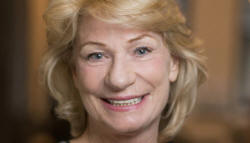|
Q&A: Squandered pennies
set the stage for the Simons Foundation
 Send a link to a friend
Send a link to a friend
 [November 16, 2016]
By Beth Pinsker [November 16, 2016]
By Beth Pinsker
NEW
YORK (Reuters) - Long before the Giving Pledge, Jim and Marilyn Simons
were donating their family's hedge fund fortune as they made it, not
saving it up to distribute after they died.
The couple met in 1973, and made their first significant gift to the
CARE global poverty charity soon after Jim's investment company,
Renaissance Technologies, took off in the 1980s. Yearly gifts turned
into a full-fledged family foundation in 1994, where they currently have
about $2 billion in assets and donate around $400 million in gifts a
year.
Marilyn Simons, 65, who holds a Ph.D in microeconomics, is president of
the foundation. She shared with Reuters what she has learned over the
years about the value of money and the best ways to make an impact
giving it away.
Q: What values did your family instill about money?
A: When we were young kids, my brother and I were sitting in the back of
a station wagon. This was in the early 1950s. We had some pennies, and
we were throwing them out of the car windows. When my father realized
what we were doing, he stopped the car and made us get out to get the
pennies that we had thrown out. That's a pretty instructive lesson. In
my family, every penny counted, bottom line.

Q: What did Jim's family teach him?
A: His grandfather had been quite successful with a shoe business, but
spent all his money frivolously. There wasn't much planning for the
future or for the next generation, and so my husband said he really
learned from that experience to spend his money wisely.
Q: What was your first experience with money you made on your own?
A: I was a Howard Johnson's fish fry girl. I was 17. I worked on the
weekends. They had a Friday night all-you-could eat special for $5.99,
and I was a waitress and carried around the fish and French fries. On my
first night of work, my whole family came and were standing on line.
They never went to Howard Johnson's, but they all went because I was
working there. They were so proud of me with my first job.
Q: When you became an economist, you focused on microeconomics. Did this
translate into some practical facility with dollars and cents?
A: When I finished my dissertation, I went on my first board and found
true happiness on the budget and finance committee. I just loved
thinking about the bottom line. Getting to apply that knowledge was
wonderful to me. I didn't pursue academia. I even took an accounting
course at some point early on when I started the foundation, so I could
do our own financial statements.
[to top of second column] |

Marilyn Simons. REUTERS/Handout/Simons Foundation

Q: How do you involve your children in your philanthropy?
A: Initially, they were very busy with their own young lives, so we'd
give them a certain amount of money that they could give away every
year. When they did get interested in doing some philanthropy, the
mission they wanted to direct their charity toward was different from
our interest in basic science research. So all three of the children
have started their own foundations.
Q: What made you want to give money away from the start, rather than
waiting?
A: There wasn't a decision point. I've read about Warren Buffett and
Bill Gates, they had a successful business and at a certain point turned
toward philanthropy. For us, it was always part of our life. The
foundation invested in Jim's fund, so everything grew along at the same
time.
Q: What do you expect the Simons Foundation to look like in 100 years?
A: Jim and I have the vision that the foundation will exist in
perpetuity. We both are very passionate about the importance of basic
science research, and we hope that the foundation will continue to fund
exciting frontiers of science and help the world and humanity by helping
increase our knowledge. It's our view that a professional, committed
board will ultimately take it over.
(Editing by Lauren Young and Bernadette Baum)
[© 2016 Thomson Reuters. All rights
reserved.] Copyright 2016 Reuters. All rights reserved. This material may not be published,
broadcast, rewritten or redistributed.

 |